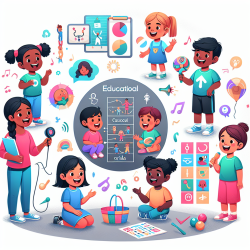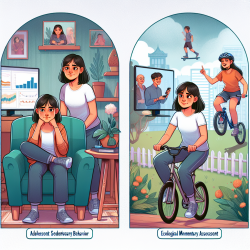Introduction
In an era where social media is a dominant force in shaping perceptions and behaviors, leveraging these platforms for positive change, particularly in the realm of substance use prevention among adolescents, is both innovative and necessary. The research article "Peer-to-Peer Social Media as an Effective Prevention Strategy: Quasi-Experimental Evaluation" sheds light on the effectiveness of using peer-driven social media interventions to reduce substance use intentions among high school students. This blog explores how practitioners can apply these findings to improve outcomes in their practice, particularly in online therapy settings like those offered by TinyEYE.
The Power of Peer Influence
The study highlights the Living the Example (LTE) program, which trains adolescent youth ambassadors to create and share prevention messages within their social media networks. This peer-to-peer approach taps into the natural influence peers have over each other, especially during the formative adolescent years. The data-driven results from this quasi-experimental evaluation demonstrate a significant reduction in substance use intentions among students exposed to LTE messages.
Key Findings
- Significant Reduction in Drug Use Intentions: Exposure to LTE messages was associated with a decrease in intentions to use substances such as marijuana, opioids, and other illicit drugs.
- Gender Differences: Boys showed a greater reduction in drug use intentions compared to girls, indicating the need for tailored approaches in messaging.
- Effective Peer-to-Peer Messaging: The study found that peer-driven social media campaigns could effectively reach large audiences at a low cost, making it a scalable solution for schools and communities.
Implications for Practitioners
For practitioners working in online therapy and educational settings, these findings underscore the importance of integrating social media strategies into prevention programs. Here are some actionable steps:
- Train Youth Ambassadors: Develop programs that empower students to become ambassadors for change, using their social media presence to influence peers positively.
- Leverage Data: Use data analytics to track the reach and engagement of social media campaigns, allowing for continuous improvement and adaptation of strategies.
- Tailor Messaging: Consider gender-specific approaches in messaging to maximize impact, as indicated by the study's findings.
Encouraging Further Research
While the LTE program shows promising results, further research is needed to refine these strategies and explore their long-term impact. Practitioners are encouraged to participate in or initiate studies that examine the effectiveness of digital interventions in diverse settings. Collaborations with academic institutions can provide the necessary resources and expertise to conduct rigorous evaluations.
Conclusion
The integration of peer-to-peer social media strategies into substance use prevention programs represents a forward-thinking approach that aligns with the digital age. By empowering youth to lead the charge, we can create a ripple effect of positive change that extends beyond the classroom and into the broader community. Practitioners are encouraged to embrace these innovative methods, leveraging data and technology to drive impactful outcomes.
To read the original research paper, please follow this link: Peer-to-Peer Social Media as an Effective Prevention Strategy: Quasi-Experimental Evaluation.










